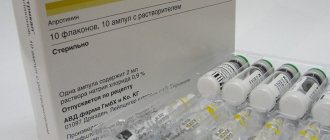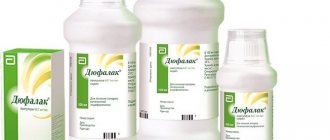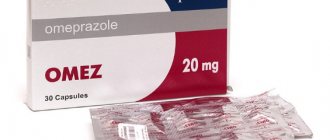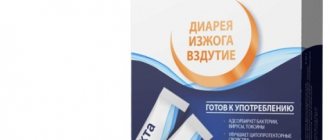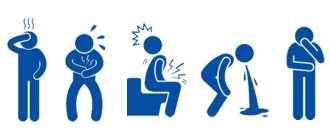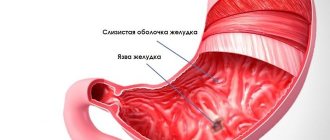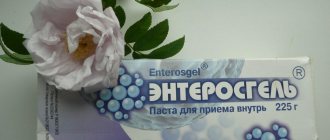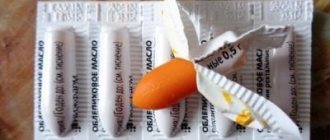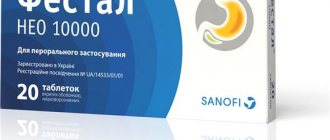Dosage
The dose of the drug is determined depending on the purpose of its use. So, if Octreotide injections are given as a prophylactic agent after pancreatic surgery, subcutaneous administration of the solution is used in the first hours after laparotomy. The patient is given three injections per day - from 100 to 200 mcg. Treatment with Octreotide is continued for five days. If the patient has an acute form of pancreatitis, subcutaneous administration of the solution is used - three times a day, 100 mcg.
The effect of using the drug occurs within 30 minutes after its administration. In the chronic form of pancreatitis, as a rule, they are limited to half the dose - 50 mcg. However, in some cases it is necessary to administer the same dose of medication as that used to treat acute pancreatitis. Only a specialist can determine the volume of administered medication. He decides how many times a day in each specific case the solution must be administered.
In case of an overdose of Octreotide, the patient may experience the following sensations:
- Heat in the face (this phenomenon is referred to as “blood rushed to the face”);
- Severe nausea;
- Empty stomach;
- Pain in the right hypochondrium and the area around the navel.
After dose adjustment or drug withdrawal, these symptoms soon disappear.
Use of Octreotide for pancreatitis
› Is it possible to cure the pancreas (pancreatitis) completely and permanently?
› Drugs for pancreatitis of the pancreas › Hormonal drugs for pancreatitis of the pancreas › Average price: from 676 to 856 rubles.
Latin name: Octreotide Active ingredient: Octreotide Manufacturer: F-Sintez JSC
Octreotide for pancreatitis helps reduce the production of serotonin and relieve the patient from dyspeptic symptoms of the pathology.
The drug, produced in injection ampoules, is used not only to treat inflammation of the pancreas, but also for preventive purposes after surgery.
The use of Octreotide depends on the purpose for which this drug is prescribed:
- For acute pancreatitis, the solution is administered subcutaneously. Dosage - 100 mcg 3 times a day. The medicine begins to act half an hour after administration of the solution.
- If the disease is in a chronic stage, then the volume of injected solution is reduced by 2 times. But for some patients, the dosage is prescribed in the same volume as for the acute form of the pathology. But the doctor determines this more accurately. The specialist also specifies the frequency of administration of the solution.
- When using Ocreotide as a prophylactic agent after surgery, the solution is administered subcutaneously. The initial injection is performed immediately after laparotomy - within the first few hours. The dosage is prescribed by the doctor - 100-200 mcg. The patient is given 3 injections per day.
Octreotide has quite a lot of side effects - from local to general:
- injections can cause vomiting and nausea, flatulence and loose stools, accumulation of gases in the intestines and acute obstruction;
- loss of appetite, disruption of the digestive system, anorexia;
- deterioration of liver function, the possibility of developing hepatitis;
- formation of gallstones;
- metabolic disease;
- glucose intolerance, carbohydrate metabolism disorders;
- disruption of the cardiovascular system;
- visual impairment.
The medicine is contraindicated for people who are sensitive to the components that make up the drug.
For cholelithiasis and diabetes mellitus, Octreotide can be used, but with great caution and under the supervision of a doctor.
When treating an acute form of pathology, the course of treatment lasts 5 days. For chronic pancreatitis, the duration of the therapeutic course is the same, but it is determined more precisely by the doctor. Preventive treatment after surgery lasts a week.
Octreotide interferes with the way some medications work. Thus, the hormone enhances or weakens the effect of a number of hypoglycemic drugs, including insulin. When using a synthetic drug together with cardioselective blockers, heart rhythm disturbances may occur, and when taken together with antihypertensive drugs, the effect of the latter is reduced.
Octreotide slows down the action of Cimetidine, an antihistamine, but enhances the therapeutic effect of Bromocriptine, a stimulator of central and peripheral receptors.
The instructions for the drug do not say anything about its compatibility with alcohol, but it should be remembered that during any treatment it is recommended not to drink alcohol.
Treatment with Ocreotide negatively affects concentration, which has a negative impact on driving.
An overdose when using the drug is possible. It is expressed by the following symptoms: flushing of the face, abdominal pain, feeling of emptiness in the stomach, nausea.
The drug should be stored in a place protected from light. The room temperature should be within +8…+28°C.
From the date of manufacture indicated on the packaging, the drug is stored for 5 years.
The active ingredient of the drug is ocreotide. It is a synthetic analogue of the hormone somatostatin, produced by the pancreas and hypothalamus (the name given to a small area in the human brain). Somastotin reduces the production of pancreatic enzymes. Octreotide has the same pharmacological action.
Excipients of Ocreotide are sodium chloride and water for injection.
Manufacturers offer this medicine in the form of an injection solution that is administered intravenously or subcutaneously. The solution is colorless and is bottled in ampoules and vials. You can also purchase the drug in the form of a lyophilisate, from which a suspension is subsequently made. The kit includes the drug, a disposable injection syringe and tampons.
A doctor can prescribe Ocreotide to pregnant women, but only if the expected benefit far exceeds the harm that can be caused to the woman and the fetus.
There is no data on whether the medicine passes into breast milk. Therefore, it is not recommended to use Octreotide while breastfeeding or should be discontinued during treatment.
Octreotide is not prescribed to children and adolescents under 18 years of age.
You can purchase the medicine only with a doctor's prescription.
You can find out more about which doctor treats pancreatitis from this article.
Use of Octreotide for pancreatitis Link to main publication
Source: https://pankreatit.guru/lechenie/preparaty/gormonalnye/oktreotid
Pharmacological properties
When taking Octreotide, the secretion of growth hormone is suppressed in the body, which makes it possible to restore the functionality of the pancreas, relieving acute and chronic inflammatory processes. The use of this remedy allows you to eliminate possible postoperative complications, including acute abscess, sepsis and pancreatic fistulas. The active substance is quickly absorbed into the body, and the maximum concentration of the drug in the blood plasma is achieved within 40 minutes after the injection. Subsequently, the drug is excreted by the kidneys and intestines.
Reviews from doctors
Alexander, Krasnoyarsk
“For moderate pancreatitis, when there is no need for surgical intervention yet, I prescribe Octreotide to my patients. The results of using this remedy are always positive, and side effects occur only when the dose is not selected exactly. A small correction is enough for the patient’s condition to return to normal.”
Irina, St. Petersburg
“In order to relieve the symptoms of acute pancreatitis, along with Octreotide, I prescribe antibiotics, antispasmodics, histamine blockers and painkillers to patients. In addition, for the first three days such patients are advised to refrain from eating and limit themselves to a small amount of water. The complex of these measures gives excellent results.”
Mechanism of action
Octreotide is a synthetically created analogue of the human hormone somatostatin, which is normally produced by the hypothalamus and a certain part of the pancreas. It is capable of suppressing for a short time the production of certain pancreatic enzymes (peptides) and stomach, as well as thyroid hormones and the entire endocrine system (serotonin). If the body does not produce enough somatostatin or if there is excessive secretion of hormones and enzymes (for example, with tumors that produce hormones and enzymes), octreotide is prescribed.
The medicine is used in the fight against many diseases. In the practice of combating pancreatitis, it was initially prescribed to prepare the pancreas for surgery and to maintain low enzyme and hormonal levels during the rehabilitation period.
Later, the ability of the drug to relieve pain during an acute attack of necrotizing pancreatitis or during an exacerbation of a chronic disease was revealed. The remedy reduces the amount of release of substances that act as aggressors to the tissues of the gland and destroy it, stopping the exacerbation.
Reviews
Dear readers, your opinion is very important to us - therefore, we will be happy to provide feedback on Octreotide for pancreatitis in the comments, this will also be useful to other users of the site.
Eva, Vologda
“I was hospitalized with an attack of pancreatitis when my daughter was only six months old. Since she was breastfed, this matter had to be curtailed immediately. The baby calmly enough switched to formula, and I finally got the opportunity to fully undergo treatment and rest. After finishing treatment, I tried to establish breastfeeding again, but my daughter herself refused. Despite this, I am very glad that I was able to take care of myself. A child needs a healthy, cheerful mother, not an inadequate one howling in pain.”
Natella, Rostov-on-Don
“Octreotide is an excellent drug. In five days he completely got me back on my feet. The only downside is the rather high cost, but, in my opinion, this is completely justified: you wasted money, ruining your health, pay to restore it.”
Properties of the product
Octreotide is absorbed quickly and has a positive effect. Reaches maximum concentration half an hour after application. The effect of the drug lasts 8-10 hours. It is excreted from the human body by the kidneys and intestines. The use of Octreotide in the treatment of pancreatitis helps as follows:
- The action of trypsin is suppressed. This substance is synthesized in the pancreas and is part of pancreatic juice. If the physiology is normal, trypsin acts as an anti-inflammatory and decongestant and breaks down necrotic cells. When the gland becomes inflamed, enzymes are rapidly activated. If there is too much trypsin, the parenchyma can be completely digested, which is why acute pancreatitis develops.
- Bicarbonate ions, which are part of enzymes, are produced more actively. They are important for normalizing balance. When there is disease in the duodenum, hydrochloric acid is highly concentrated, which causes irritation and pain. Thanks to bicarbonate ions, the environment becomes alkaline, and the effect of hydrochloric acid is neutralized.
- Antispasmodic effect. The channels of the ductal system narrow. This leads to a decrease in the outflow of enzymes into the gland itself.
- Serotonin is not produced in such large quantities, and general poisoning of the body does not occur.
- The production of insulin and some other hormones is reduced.
- Enzyme function decreases as food intake progresses.
- Reduces the risk of infection, fistulas and abscesses, as well as other complications after surgery
Pharmakinetics
After injection, the medicine is quickly and completely absorbed into the blood; the maximum active substance in the blood is recorded half an hour after the injection. It has a therapeutic effect for ten hours, then is excreted by the kidneys and through the intestines. The therapeutic effect is as follows:
- The action of the enzyme trypsin and others is inhibited, which during pancreatitis are excessively activated inside the gland itself and destroy (digest) the parenchyma of the organ.
- Promotes the production of bicarbonate ions, which regulate the pH of pancreatic juice, neutralizing the effect of hydrochloric acid.
- A spasmodic narrowing of the pancreatic ducts occurs.
We also recommend viewing: Ryazhenka for pancreatitis: is the product allowed to be consumed?
The prolonged action of the suspension from the Octreotide-Depot lyophilisate is due to the fact that it consists of microspheres with a polymer matrix carrier of the hormone octreotide. Once injected into the muscle tissue, the microspheres begin to gradually break down (over about 3-4 weeks), the hormone is released in small portions and has a therapeutic effect.
Purpose of octreotide
For inflammation of the pancreas (pancreatitis), octreotide is administered to reduce the activity of digestive enzymes in preparing the gland for surgery and for its rehabilitation. During the use of the drug, its analgesic property was revealed during acute attacks of necrotizing pancreatitis and during exacerbation of its chronic form.
Because In case of pancreatitis, enzymes become aggressor substances in relation to the gland tissue, then a decrease in their level reduces the inflammatory process and reduces pain. The drug is administered to the patient by injection. The drug is also prescribed for the appearance of pancreatic pseudocysts and fistulas. There is a practice of prescribing it for cirrhosis, peptic ulcers, and bleeding of esophageal vessels.
Reviews from medical professionals and patients
Not all doctors, including surgeons, unconditionally recognize the effectiveness of octreotide for pancreatitis. Some believe that the effectiveness of the drug has not been sufficiently proven, so it should not be used. And before surgery, it is enough to free the digestive tract from food debris and fast.
Patients suffering from pancreatitis often respond positively to Octreotide. Usually in clinics they resort to it after using other medications that did not have a sufficient effect on the course of the exacerbation. But it is also noted that a repeated course after some time is no longer so effective, perhaps due to sensitization, because the number of side effects increases, in particular nausea.
Thus, the use of octreotide for pancreatitis is acceptable and in some cases has a positive effect on the development of the disease. More often, the need to use it is arrived at empirically (trial and error). If the treatment is carried out under the supervision of doctors, the effect is noticeable.
It should be noted that online discussions regarding the use of this drug and its effectiveness are rare. Typically, users ask questions to specialists asking how effective therapy is for a particular disorder.
However, in clinical practice, the Depo form is predominantly used. At the same time, reviews of Octreotide-Depot show that it is used for pancreatitis, as well as acute and chronic forms of this disorder. Of course, this remedy is prescribed only by a specialist and you should expect that treatment will be carried out for at least a week.
Description of the drug and dose of administration
Octreotide is available in the form of a solution (0.01 and 0.005%) for subcutaneous and intravenous injections. The product is colorless and odorless.
Applicable:
- subcutaneously - it is recommended to administer the drug three times a day, 50 - 300 mcg in the first 5 days for acute pancreatitis or the condition before and after surgery;
- intravenously - the drug is administered through a dropper, allowing you to administer up to 1200 mcg per day for 5 - 15 days;
- intramuscularly - a long-acting drug, the so-called octreotide depot, which is a lyophilisate for diluting a suspension intended for deep administration once a month, is becoming increasingly popular.
It is under no circumstances recommended to self-prescribe octreotide, even if this prescription drug is within reach. Changing the prescribed dose is also fraught with a worsening of the condition - self-medication is excluded for diseases of the pancreas.
Pharmaceutical form, doses
Octreotide is a colorless transparent solution for injection in various packaging (glass ampoules or vials of 1 or 5 ml) and concentration:
- 50 μg (0.05 ml)/ml;
- 100 μg (0.1 ml)/ml;
- 500 μg (0.5 ml)/ml;
- 1000 µg/5 ml (200 µg or 0.2 ml/ml);
- 5000 µg/5 ml (1000 µg or 1.0 ml/ml).
We also recommend viewing: Sour cream for different forms of pancreatitis
In addition to octreotide, the solution contains water for injection and sodium chloride. The drug is also available in the form of a dried powder (lyophilisate). A long-acting suspension is prepared from the powder. At the structural level, the lyophilisate is a microsphere containing a polymer matrix. It is the carrier of the main substance. Of course, only the doctor prescribes doses and regimens, but approximate courses of therapy can be given:
- Acute attack of pancreatitis. Dose: from 50 to 300 mg three times (sometimes twice) per day, injections are given subcutaneously for 5 days. The second option is droppers for 5 days up to 1200 mcg daily.
- Chronic pancreatitis. Subcutaneous injection of 200 mcg of the drug three times a day for three weeks.
- Recovery after partial pancreatectomy. The first injection is given subcutaneously 1 or 2 hours before surgery. After surgery, subcutaneous injections of 100-200 mcg three times a day for 5-7 days.
- Prolonged drug administration. Once a month, intramuscular injection of a suspension prepared from Octreotide-Depot lyophilisate, as deep as possible into the muscle.
Important. The drug should be at room temperature so that there is no discomfort at the injection sites. You cannot inject in the same places.
If the drug is prescribed for the first time, then it is better to choose minimal doses - no more than 0.1 mg subcutaneously three times a day for 1-2 weeks and observe the level of tolerability and effectiveness.
The patient should not be alarmed if on some days there is an increase in clinical symptoms characteristic of pancreatic diseases. This phenomenon is sometimes observed during treatment with octreotide injections. In these cases, it is recommended to additionally administer the drug at the initial dose. When a therapeutic concentration of the drug in the blood plasma is reached, this phenomenon, as a rule, does not recur.
An overdose of a drug is manifested by the following symptoms:
- short-term decrease in heart rate;
- sensations of a rush of heat to the face, its redness;
- the occurrence of painful cramps in the abdominal area;
- diarrhea;
- attacks of nausea,
- feeling of emptiness in the stomach.
Important. In this case, the drug is discontinued and treatment for the above symptoms is prescribed.
Instructions for use
The dosage of the drug, as well as the duration of the course of treatment, is selected by a specialist based on diagnostic data, the stage of the pathology, and the symptoms of the disease he or she has. The following doses of Octreotide are prescribed depending on the purpose of use and symptoms:
- To stop ulcer bleeding, a five-day course of daily infusions of 50 mg of a one percent solution is carried out.
- Treatment of bleeding from the stomach and esophagus is performed with infusions of 25-50 micrograms daily for 5 days.
- When treating acute pancreatitis, 3 infusions of the drug are performed per day for 5 days. In rare cases, in the presence of acute symptoms, the doctor may prescribe a large dose of medication, and such treatment is performed under the supervision of a specialist in a hospital setting.
- To prevent postoperative complications on the pancreas, patients are given three infusions of 100−200 micrograms of the drug.
- For tumors of the endocrine system, the initial dose of Octreotide is 50 micrograms. Subsequently, the doctor, depending on the patient’s condition and diagnostic data, may increase or decrease the dose of the drug. It is necessary not only to determine the patient’s existing diseases and correctly select therapy, but also to correctly perform subcutaneous administration of Octreotide.
Injection rules:
- Injecting in the same place after a short period of time is prohibited.
- It is not recommended to store the unused solution.
- The ampoule is opened immediately before the injection.
- The solution is warmed to room temperature.
- Before opening, the ampoule should be inspected for changes in the color of the drug and the presence of foreign impurities in it.
Impact on the effectiveness of other drugs
Octreotide interacts quite actively with other medications. It enhances the effects of some and reduces others.
Examples of interaction:
- combined use with cardiac blockers, such as Cardolax acebutolol, metoprolol, mibefradil leads to a slowdown in heart rate or arrhythmia;
- strongly affects the therapeutic effect of drugs for patients with diabetes (insulin, zinc insulin suspension, acarbose, glipizide and the like);
- reduces the effectiveness of medications for hypertensive patients;
- impairs the absorption of the antiulcer drug Cimetidine and the immunosuppressant Cyclosporine;
- Helps the bioavailability of Bromocriptine (an ergot alkaloid derivative).
When combined with the above drugs and octreotide, therapeutic doses should be prescribed with caution, the patient's condition should be monitored and treatment tactics should be empirically adjusted.
special instructions
In the presence of a pituitary tumor, it is necessary to monitor the patient’s condition, in particular, constantly monitor the size of the tumors and change the dosage of the drug accordingly. When treating endocrine gastropancreatic tumors, a sudden acute relapse of symptoms may occur. Administration of Octreotide for pancreatitis in the intervals between sleep and meals can reduce side effects from the gastrointestinal tract.
To identify an allergy to the drug, it is recommended to conduct a trial infusion, based on the results of which the doctor will decide on the prescription of this medicine and its optimal dosage. It is not recommended to perform injections and infusions through droppers with a cold solution. This increases the pain from the medicine and impairs its absorption by the body. With long courses of treatment, which can reach 12 months, it is necessary to perform ultrasound of the gallbladder on a regular basis.
This will allow you to diagnose the appearance of stones in the ureters. Gallstone disease is asymptomatic; therefore, by identifying such formations at an early stage, they can be crushed with ultrasound, which will avoid the need for complex surgery. During the treatment period, regardless of the duration of the course and dosage of the drug, systematic monitoring of the patient's condition is necessary. The physician should monitor blood glucose concentrations, especially in patients with cirrhosis of the liver and esophageal varices.
With correct diagnosis and timely administration of Octreotide, the prognosis is positive. Soon after starting injections and drips, the patient feels an improvement in health, and with long courses, complete recovery is possible even in severe forms of the disease. Octreotide shows excellent results as a prevention of pancreatic diseases.
The components contained in the drug reduce inflammation of this internal organ, regenerate its cells, and eliminate all symptoms of existing diseases. High-quality treatment implies an integrated approach, including the correct selection of therapy, as well as adherence to a special diet that contains a minimum of fatty foods. This will ensure complete recovery even in the presence of chronic pathologies.
Indications for use
Octreotide is actively used in prescribing intensive therapy for patients suffering from one or another form of pancreatitis. Only the attending physician, who has a clear picture of the patient’s well-being, the diseases he has suffered and a detailed medical history, has the right to prescribe the drug. Only the correct dosage can improve the functioning of the pancreas.
Octreotide is prescribed for the following diagnoses:
- acute pancreatitis;
- stomach ulcer;
- pancreatic pseudocyst;
- cirrhosis of the liver;
- cholecystitis;
- pain in the pancreas;
- pancreatic fistula;
- complications after surgical interventions and operations on internal organs in the peritoneum.
Octreotide is also prescribed to patients who have internal bleeding, especially in the abdominal cavity, with ruptured veins or thrombosis. This treatment is carried out in a hospital. Weighing all the indications, Octreotide for pancreatitis is prescribed as the main medication in treatment, adding to it only auxiliary drugs that relieve swelling and accelerate the healing process of damaged tissue, for example, after removal of the pancreas.
Contraindications and side effects
Octreotide is prescribed exclusively by a doctor, since it is one of the medications of choice for pancreatitis, and not the only one of its kind.
Some patients experience undesirable consequences of taking the medicine:
- dyspeptic symptoms - nausea, vomiting, abdominal cramps, bloating, loose stools, in rare cases, acute hepatosis;
- heart rhythm disturbances – bradycardia and arrhythmia;
- changes in the absorption of carbohydrates - impaired glucose tolerance, hypo- and hyperglycemia, suppression of insulin production;
- local reactions - redness and pain in the injection area;
- allergic phenomena - urticaria, peeling of the integument, itching, difficulty breathing.
A serious side effect is the formation of stones in the gall bladder and excretory tract. In rare cases, serious disorders occur in the intestines - up to paresis. But with short courses of treatment (up to 2 weeks), there is no need to worry about these phenomena.
When prescribing a drug for pancreatitis, the doctor takes into account the risks of possible complications, and during treatment strictly monitors not only the therapeutic effect, but also the condition of the body as a whole. Therefore, the use of octreotide is justified only when prescribed by a doctor.
There are several contraindications for use:
- age under 18 years;
- pregnancy and breastfeeding;
- individual intolerance.
Octreotide is prescribed with caution to expectant mothers suffering from gallstone disease and type 1 diabetes. Breastfeeding women should not take the drug, because its effect on a breastfeeding child has not been studied at its concentration in human milk. If it is necessary to use the drug, you need to switch to artificial feeding. The active ingredient of the drug is based on a hormone, so undesirable side effects, local or general, may occur:
- Vomiting, nausea, flatulence and bloating. Gases accumulate in the intestines, causing loose stools.
- A high concentration of fats is detected in the stool. Sometimes there are signs of acute intestinal obstruction.
- Anorexia. The use of the drug causes a decrease in appetite. Digestion is disrupted. Due to dyspeptic disorders and constant diarrhea, general exhaustion of the human body occurs. The result is anorexia.
- The liver works worse. There is a risk of developing acute hepatitis of an infectious nature. In this case, the liver not only becomes inflamed, but also enlarges and is painful on palpation. A likely sign is the release of bilirubin pigment into the blood.
- Stones form in the gallbladder. Stones form due to constant use of the drug. Patients who have been undergoing treatment for a long time should make an appointment for an abdominal ultrasound every six months. If stones are diagnosed, the doctor adjusts the treatment regimen on a personal basis.
- Exacerbation of disturbing symptoms in the first days of taking the medicine.
- Metabolic disorder.
- Due to the fact that Octreotide suppresses insulin production, patients develop glucose intolerance. Then carbohydrate metabolism develops.
- In patients suffering from neuroendocrine tumors, a chronic increase in glucose is diagnosed. It is important to constantly monitor the sugar balance and adjust the dose of the product.
- Disturbances in the functioning of the heart and blood vessels. The heart rate slows down.
- Vision problems. Such patients should receive additional treatment.
- In patients with type 1 diabetes, Octreotide reduces the need for a specific amount of insulin if patients receive insulin systematically. To reduce the risk of side effects, it is necessary to administer the drug between meals, as well as before resting at night. In order to cope with sudden jumps in glucose concentration, you need to administer Octreotide more often, and take smaller doses.
The main adverse events observed with the use of octreotide were side effects from the digestive, nervous, and hepatobiliary systems, as well as metabolic disorders and the development of nutritional deficiencies.
From the digestive system: very often - diarrhea, abdominal pain, nausea, constipation, bloating; often - dyspeptic disorders, vomiting, feeling of fullness/heaviness in the abdomen, steatorrhea, soft stool consistency, change in stool color, anorexia.
From the nervous system: very often - headache; often - dizziness.
From the endocrine system: very often - hyperglycemia; often - hypothyroidism/thyroid dysfunction (decreased levels of thyroid-stimulating hormone, total and free thyroxine); hypoglycemia, impaired glucose tolerance.
From the hepatobiliary system: very often - cholelithiasis, i.e. formation of gallstones; often - cholecystitis, impaired colloidal stability of bile (formation of cholesterol microcrystals), hyperbilirubinemia, increased activity of liver transaminases.
Dermatological reactions: often – itching, rash, hair loss.
From the respiratory system: often - shortness of breath.
From the cardiovascular system: often – bradycardia; sometimes - tachycardia.
General disorders and reactions at the injection site: very often - pain at the injection site; sometimes – dehydration.
During therapy with octreotide, the following adverse events were observed in clinical practice, regardless of the presence of a cause-and-effect relationship with the use of the drug:
From the immune system: anaphylactic reactions, allergic reactions/hypersensitivity.
Dermatological reactions: urticaria.
From the hepatobiliary system: acute pancreatitis, acute hepatitis without cholestasis, cholestatic hepatitis, cholestasis, jaundice, cholestatic jaundice, increased levels of alkaline phosphatase, gamma-glutamyl transferase.
From the cardiovascular system: arrhythmias.
Interaction with other drugs
In the first days of using the medicine, the symptoms of the disease may worsen. Since the active ingredient of the drug is a hormone, unpleasant side effects are possible, for example:
- bloating;
- flatulence;
- nausea;
- vomit;
- accumulation of gases in the intestines;
- loose stool.
Fats are concentrated in stool. Periodically, acute obstruction appears in the intestines. Taking the drug worsens appetite and disrupts digestion. Against the background of incessant diarrhea and dyspeptic disorders, the human body is depleted. All this sometimes leads to anorexia.
Liver function deteriorates. Acute hepatitis of an infectious nature may even develop. When inflamed, the liver enlarges and hurts on palpation. The release of bilirubin into the blood may indicate problems of this type.
Often, with constant use of Ocreotide, stones appear in the gallbladder. Patients who are forced to undergo treatment for a long time should come for an ultrasound scan of the abdominal cavity once every six months. When stones are detected, the treatment regimen is adjusted by the doctor. The work of the heart and blood vessels is disrupted, and the rate of contractions decreases. Possible vision impairment.
There are disruptions in metabolism. Because the drug reduces insulin production, it leads to the development of glucose intolerance. Glucose even chronically increases in patients with neuroendocrine tumors. It is important to monitor your blood sugar levels. However, if you have type 1 diabetes, the need for the previous volumes of insulin decreases - it is already systematically obtained by patients.
Octreotide affects the work of some medications, in particular hypoglycemic ones, weakening or enhancing their effect. Its use in parallel with cardioselective blockers sometimes leads to heart rhythm disturbances. It reduces the effectiveness of antihypertensive drugs.
The drug reduces the activity of the antihistamine Cimetidine, but improves the effect of Bromocriptine, which stimulates peripheral and central receptors. There is no scientific data regarding the compatibility of Ocreotide with alcohol. However, alcohol is generally not indicated for serious treatment. This drug also impairs concentration and attention.
Analogs
Analogues of Octreotide are:
- Sandostatin;
- Sandostatin lar;
- Genfastat;
- Octreotide Sun;
- Octreotide Fsynthesis;
- Octreotide Kabi;
- Octreotide Actavis;
- Octreotide depot;
- Octreotide-long;
- Octretex;
- Octreotide Acetate;
- Pentetreotide;
- Octride.
Octreotide is available in pharmacies only by prescription, so the likelihood that a patient will try to use it on their own is practically reduced to zero. But even if you have this remedy in your hands, you should not risk your health. See your doctor. This will help avoid many problems.
Compound
According to the instructions, Octreotide is produced in the form of a solution for injection, both subcutaneously and intravenously. 1 ml of solution contains 50 or 100 mcg of the active component octreotide. The contents of one ampoule can be diluted with water for injection or sodium chloride, depending on the route of administration. One package contains 5 ampoules of 1 ml solution.
As the instructions for use indicate, Octreotide 20 mg and 30 mg is a long-acting drug, a lyophilisate for preparing a suspension. It's called Octreotide Long.
